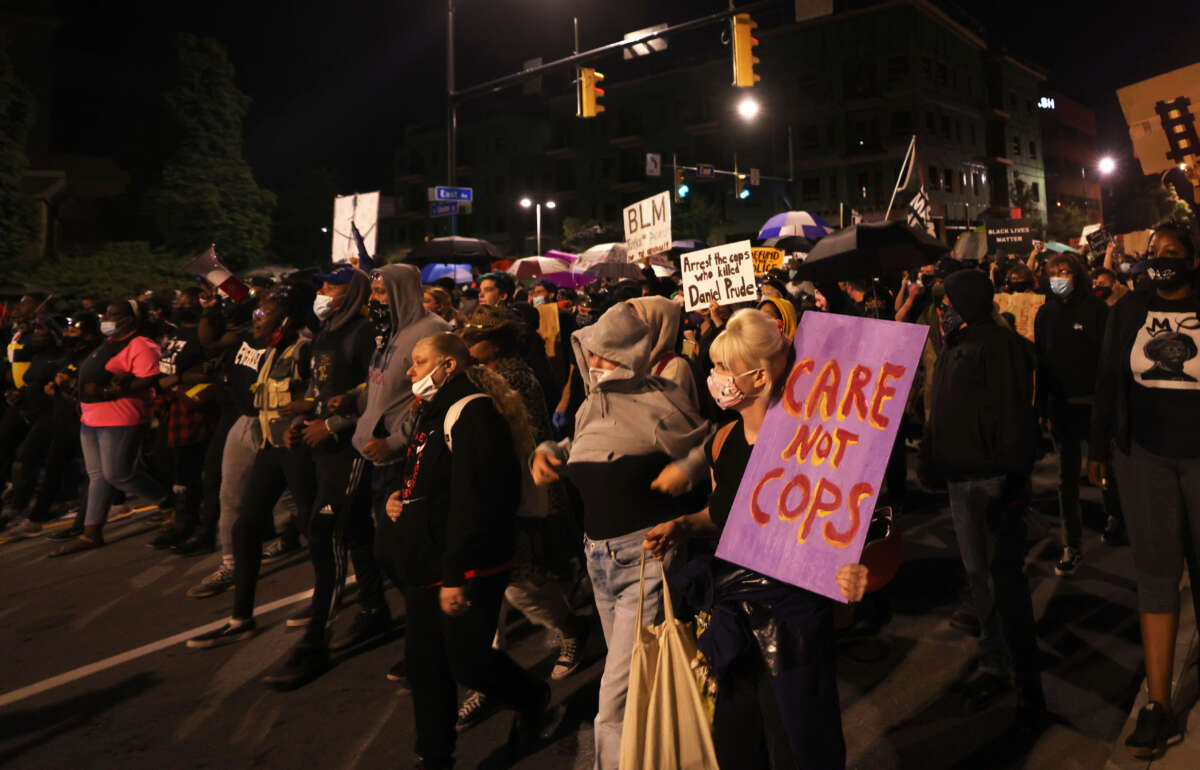When police officers found Daniel Prude naked and wandering the streets of Rochester, New York, as snow was falling the evening of March 23, 2020, they did not call for social workers or mental health experts. They pointed a Taser at him and demanded he lie on the ground. Prude had run out of his brother’s house during a mental health crisis, and after a few minutes of sitting handcuffed on the cold, wet street, grew agitated.
The officers placed a mesh hood over his head to prevent the potential spread of COVID-19, increasing his distress. Three officers pinned him to the ground, with one pressing his knee on Prude’s back and another pushing his face into the pavement. After two minutes, he stopped breathing. Between gasps of air and prayers, he said, “You’re trying to kill me.” Prude was pronounced brain dead upon arriving at the hospital and died a week later.
Prude’s story is not an anomaly. As we celebrate the 33rd anniversary of the Americans with Disabilities Act (ADA), we also mark another year in which people with disabilities are trapped in the criminal legal system instead of receiving the support they need.
Without safe and affordable housing and supportive community-based services, people with disabilities are more likely to live in poverty, be unemployed or be unhoused. These factors make it more likely that people with disabilities will interact with law enforcement — often for misunderstood behavior related to their disabilities — and become ensnared in the criminal legal system. Once in the system, people with disabilities suffer more discrimination and trauma, and are denied housing and community-based services like supported employment and peer services that could change — and save — their lives.
While roughly 15 percent of the United States population has a physical or mental disability, 40 percent of people in state prisons have a disability. About one-quarter of incarcerated people have cognitive disabilities such as autism, Down Syndrome and learning disorders, while many others have visual, hearing and ambulatory disabilities. Although people with mental health disabilities comprise only 4-5 percent of the U.S. population, they make up about 15 percent of prison and 20 percent of jail populations. Not because they are more violent or engage in more criminal conduct; because they are set up to fail and unduly put in harm’s way.
Law enforcement officers are generally the first and only responders to be dispatched when people with mental disabilities experience a crisis or otherwise need help, when they should receive the same type of health-centered response provided to someone experiencing a physical health emergency, such as a heart attack. In mental health emergencies, mental health experts and peers with lived experience should take the lead, not law enforcement.
Similarly, a deaf person may need a sign language interpreter to help facilitate communication and avoid being attacked or punished for perceived noncompliance. A person with a cognitive or other mental disability may need a companion to explain proceedings to them so they can defend themselves. In all these scenarios, to do otherwise violates the ADA and puts lives at risk.
It doesn’t have to be this way. All actors in the criminal legal system should understand the civil rights of people with disabilities and confront implicit biases and assumptions. They also must be trained to recognize that manifestations of disability, such as inability to speak or noncomprehension due to a hearing or mental disability, do not equal noncompliance or hostility.
Public safety requires reforming the systems that serve people with disabilities. People with disabilities can live successfully in their own homes and communities and avoid law enforcement contact when they receive the services they need — and that are mandated by the ADA. Community-based assistance with housing, employment and needed treatment improves the lives of people with disabilities, and helps them avoid harmful law enforcement contacts and subsequent incarceration or hospitalization.
We need alternatives to police responses for people with behavioral health disabilities. Some communities like Eugene, Oregon, are already doing this with proven success. In their CAHOOTS program, a medic and social worker, both unarmed, are dispatched to most behavioral health calls, instead of the police. The program reports that each year it saves the city $8.5 million in public safety costs and $14 million in ambulance and emergency room costs. San Francisco, California, has adapted the CAHOOTS model so that it includes a peer responder on the team. An even greater number of communities are investing in mental health crisis teams, which include a clinician and often a peer, and can be dispatched by 911, law enforcement or the mental health system.
Individuals with disabilities — and their neighbors — are far better served when public safety systems help them avoid unnecessary and traumatizing interactions with police in the first place.
Fulfilling the ADA’s promise of equal opportunity, full participation, independent living and economic self-sufficiency for people with disabilities requires more than making society’s physical spaces accessible. It also means providing full and equal access to all aspects of daily life so people with disabilities can live successfully in their own homes and communities, instead of cycling through courts and carceral settings with harmful consequences.
Media that fights fascism
Truthout is funded almost entirely by readers — that’s why we can speak truth to power and cut against the mainstream narrative. But independent journalists at Truthout face mounting political repression under Trump.
We rely on your support to survive McCarthyist censorship. Please make a tax-deductible one-time or monthly donation.
